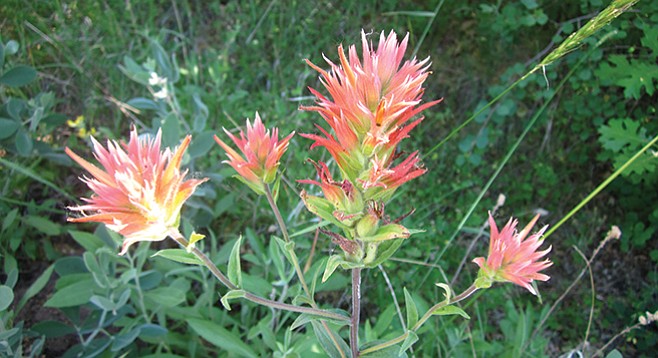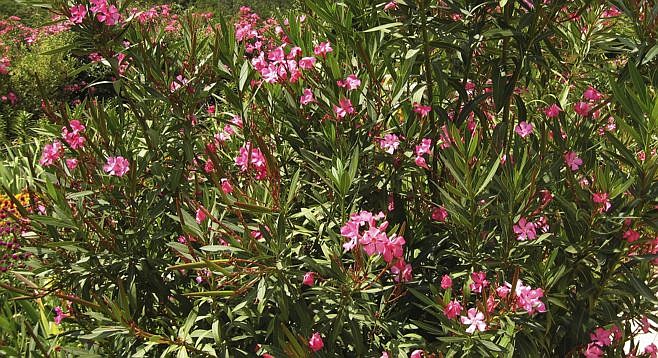 Facebook
Facebook
 X
X
 Instagram
Instagram
 TikTok
TikTok
 Youtube
Youtube

Spring Wildflowers have largely dried up in many areas of San Diego County, but in the cooler coastal enclaves such as Cabrillo National Monument and Torrey Pines State Reserve, several kinds remain. Look for paintbrush, purple nightshade, coreopsis, sea fig, popcorn flower, and red monkey flower, among others.

Oleander Bushes, now beginning to bloom in gardens and along roadsides in the interior valleys and desert, will continue putting on a good show through the summer. Good displays of white, pink, and red varieties can be seen along the medians of Interstate 8 in east El Cajon and along Interstates 5 and 15 in parts of North County. Oleander’s toxic characteristics are well-known: all parts of it are poisonous if ingested.
Blooming of Desert Annuals is over, but not so for the stolid desert willows and smoke trees. Rooted to the beds of dry washes throughout Anza-Borrego’s lower valleys, both plants gather enough energy this time of year to put on an impressive floral show. The graceful, drooping branches of the desert willow hold fragrant, white blossoms, while the spindly smoke tree exhibits myriads of blue-purple flowers. To avoid the intense midday heat, confine your desert explorations to early morning or early evening. And watch out for bees — they’re attracted to the blossoms, too.
On the night of May 30-31, we might have a brief-but-intense meteor display, thanks to a comet that split apart in 1995 and is still fragmenting. It might happen as Earth passes through a particularly dense stream of icy particles which the comet left behind in the years 1995, 1897 and 1892. The meteor shower is the Tau Herculids; astronomers found it in 1930 and it orbits the sun every 5.4 years. Will we get a wonderful meteor display? We never know for sure. It would be at around 10:04 pm in San Diego and all within a 22-minute span. A strong meteor shower or a meteor storm will be memorable. If no shower develops, you’ll be among the first to know!
The above comes from the Outdoors listings in the Reader compiled by Jerry Schad, author of Afoot & Afield in San Diego County. Schad died in 2011. Planet information from SkyandTelescope.org.


Spring Wildflowers have largely dried up in many areas of San Diego County, but in the cooler coastal enclaves such as Cabrillo National Monument and Torrey Pines State Reserve, several kinds remain. Look for paintbrush, purple nightshade, coreopsis, sea fig, popcorn flower, and red monkey flower, among others.

Oleander Bushes, now beginning to bloom in gardens and along roadsides in the interior valleys and desert, will continue putting on a good show through the summer. Good displays of white, pink, and red varieties can be seen along the medians of Interstate 8 in east El Cajon and along Interstates 5 and 15 in parts of North County. Oleander’s toxic characteristics are well-known: all parts of it are poisonous if ingested.
Blooming of Desert Annuals is over, but not so for the stolid desert willows and smoke trees. Rooted to the beds of dry washes throughout Anza-Borrego’s lower valleys, both plants gather enough energy this time of year to put on an impressive floral show. The graceful, drooping branches of the desert willow hold fragrant, white blossoms, while the spindly smoke tree exhibits myriads of blue-purple flowers. To avoid the intense midday heat, confine your desert explorations to early morning or early evening. And watch out for bees — they’re attracted to the blossoms, too.
On the night of May 30-31, we might have a brief-but-intense meteor display, thanks to a comet that split apart in 1995 and is still fragmenting. It might happen as Earth passes through a particularly dense stream of icy particles which the comet left behind in the years 1995, 1897 and 1892. The meteor shower is the Tau Herculids; astronomers found it in 1930 and it orbits the sun every 5.4 years. Will we get a wonderful meteor display? We never know for sure. It would be at around 10:04 pm in San Diego and all within a 22-minute span. A strong meteor shower or a meteor storm will be memorable. If no shower develops, you’ll be among the first to know!
The above comes from the Outdoors listings in the Reader compiled by Jerry Schad, author of Afoot & Afield in San Diego County. Schad died in 2011. Planet information from SkyandTelescope.org.
Comments